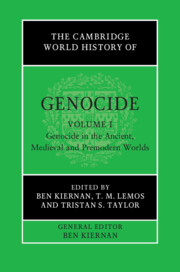Book contents
- The Cambridge World History of Genocide
- The Cambridge World History of Genocide
- The Cambridge World History of Genocide
- Copyright page
- Contents
- Figures
- Maps
- Tables
- Contributors to Volume I
- General Editor’s Acknowledgements
- General Editor’s Introduction to the Series
- Introduction to Volume I
- Part I Themes of Genocide through History
- Part II The Ancient World
- 6 Genocide in Ancient Israelite and Early Jewish Sources
- 7 Genocide in Ancient Mesopotamia during the Bronze and Iron Ages
- 8 Urbicide in the Ancient Greek World, 480–330 bce
- 9 Violence, Emotions and Justice in the Hellenistic Period
- 10 A Tale of Three Cities
- 11 Caesar’s Gallic Genocide
- 12 Genocidal Perspectives in the Roman Empire’s Approach towards the Jews
- 13 Religious Violence in the Later Roman Empire
- 14 Genocide, Extermination and Mass Killing in Chinese History
- Part III The Medieval World and Early Imperial Expansions
- Index
7 - Genocide in Ancient Mesopotamia during the Bronze and Iron Ages
from Part II - The Ancient World
Published online by Cambridge University Press: 23 June 2023
- The Cambridge World History of Genocide
- The Cambridge World History of Genocide
- The Cambridge World History of Genocide
- Copyright page
- Contents
- Figures
- Maps
- Tables
- Contributors to Volume I
- General Editor’s Acknowledgements
- General Editor’s Introduction to the Series
- Introduction to Volume I
- Part I Themes of Genocide through History
- Part II The Ancient World
- 6 Genocide in Ancient Israelite and Early Jewish Sources
- 7 Genocide in Ancient Mesopotamia during the Bronze and Iron Ages
- 8 Urbicide in the Ancient Greek World, 480–330 bce
- 9 Violence, Emotions and Justice in the Hellenistic Period
- 10 A Tale of Three Cities
- 11 Caesar’s Gallic Genocide
- 12 Genocidal Perspectives in the Roman Empire’s Approach towards the Jews
- 13 Religious Violence in the Later Roman Empire
- 14 Genocide, Extermination and Mass Killing in Chinese History
- Part III The Medieval World and Early Imperial Expansions
- Index
Summary
This chapter explores the related questions of whether or not genocide is found in sources from ancient Mesopotamia and whether ancient Mesopotamian empires carried out genocidal violence. The chapter focuses on the three most relevant sets of sources from Mesopotamia: evidence from the 23rd century BCE related to the violent reprisals of two kings of Akkad, Rimuš and Naram-Sin, against the “rebellious” cities of Sumer and Elam; the Sumerian “city laments” dating to a few centuries later; and first-millennium BCE Neo-Assyrian royal inscriptions. This examination demonstrates that, while mass violence is hardly rare in accounts of Mesopotamian history, finding evidence for genocide is not a straightforward task. Whether or not the Mesopotamians practiced genocide hinges on how one defines that term, and whether the targeted destruction of cities constitutes a type of genocide. In addition to an exploration of urbicide as genocide, the chapter considers how Mesopotamian accounts of mass violence contributed to accounts and practices of violence, including genocidal violence, elsewhere in ancient West Asia in later periods.
Keywords
- Type
- Chapter
- Information
- The Cambridge World History of Genocide , pp. 209 - 234Publisher: Cambridge University PressPrint publication year: 2023



